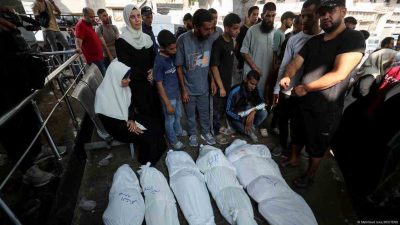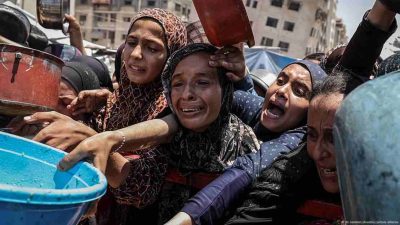
Displaced faces food shortages and limited help amid constant Israeli bombing. To DW, inhabitants of the enclave report daily life of despair.
Every day they are full of anxiety and exhaustion. The constant Israeli bombings, lack of sleep and the search for food are overwhelming for the displaced population of the Gaza Strip.
“The day revolves around thinking where to find food for my family,” said Raed Al-ATHAMNA, a Palestinian father displaced in the city of Gaza, who spoke to the DW report by telephone, as foreign journalists are forbidden to enter Gaza.
“There is nothing to eat. There is no bread, because I have no money to buy flour. It’s very expensive. Today, we had some lentils for the kids and my mother, but tomorrow, I don’t know.”
Al-Athamna, who once worked as a driver for foreign journalists in Gaza, said she had no more words to describe the situation. “There are air strikes and Israeli bombings all the time. I’ve seen people fainting on the streets for not having eaten. Social networks are full of videos of people simply fainting.”
Garlets deteriorate at a point of passage: “The terrible is that everyone knows that food is only 10 kilometers away,” says a member of the NGO | Amir Cohen/Reuters
The DW report had last talked to Al-Athamna in May, shortly after the Israeli government authorized the entry of some humanitarian aid trucks in Gaza after a blockade of almost three months. At the time, he believed that the situation could not get worse for the 2.1 million inhabitants of Gaza.
Two months later, Al-Athamna describes the situation as very bad. “You can’t find a piece of bread, it’s a very difficult situation. I’m here with my grandchildren, they are crying, saying, ‘We want a piece of bread.’ And if you can’t give them anything, they don’t understand. It breaks the heart.”
NGOs issue alert
International Health and Humanitarian Assistance Organizations have repeatedly warned about the conditions and the lack of vital supplies in Gaza during the conflict, which already lasts 21 months.
According to the United Nations Office for the Coordination of Humanitarian Affairs (OCHA), almost 88% of Gaza is under evacuation orders or designated as a military zone. These areas include most Gaza’s agricultural lands, concentrating the displaced population in an increasingly limited space and complicating humanitarian access.
The head of the World Health Organization, Tedros Adhanom Ghebreyesus, said on Wednesday that a large part of the population of Gaza is starving. “I don’t know how you would call it beyond mass hunger; it’s a disease caused by man and that’s very clear,” he said.
Ross Smith, director of emergency of the World Food Program (WFP), said on Monday that the hunger crisis in Gaza “reached new and amazing levels of despair.” He stated that “one third of the population does not eat for several days in a row, including women and children.”
 Explosion between ruins in the Gaza Strip: attacks continue in the midst of the acute crisis of hunger | Amir Cohen/Reuters
Explosion between ruins in the Gaza Strip: attacks continue in the midst of the acute crisis of hunger | Amir Cohen/Reuters
On Thursday (07/24), the Gaza Ministry of Health, controlled by Hamas, said that, so far, in July, 48 Palestinians died of malnutrition, with 59 deaths from malnutrition since the beginning of 2025. This number is higher than 50 registered in the previous year, when Israel began his war against Hamas in Gaza after the group’s terrorist offensive. on October 7, 2023. Israeli authorities challenged such allegations, characterizing them as propaganda.
Food prices shoot
Eyad Amin, 43, the father of three young children who found shelter in the city of Gaza, is desperate. “There is no food available and when there is, it is very expensive,” he told DW.
Amin, a former done of a stationery, managed to buy some vegetables, but at prices that most people cannot afford. “Today I bought two potatoes, two tomatoes and some green peppers. These simple items cost me 140 shekels [cerca de R$ 234]”, These.
Like most Palestinians in Gaza, Amin has no income, but receives help from relatives abroad. Those without this support face even greater difficulties.
Sherine Qamar, mother of two children in the north of Gaza, depends on parents’ support. “We live practically without food, and what we eat is just to survive. We all lose a lot of weight; I personally lost 15 pounds in the last four months,” she said.
 According to the American NGO, since early July, the cases of children with acute malnutrition have almost tripled | Unrwa/Imago
According to the American NGO, since early July, the cases of children with acute malnutrition have almost tripled | Unrwa/Imago
Medical care has additional challenges. “When my children get sick by malnutrition or problems such as influenza, we are unable to find medicine in hospitals or pharmacies, and we have to wait long hours in international organizations and hospitals for painkillers,” Qamar told DW.
Acute Malnutrition triple among children
In March, the Israeli authorities closed the tickets to Gaza, claiming concerns about diversion of humanitarian aid to Hamas. These restrictions were partially suspended in May, when Israeli Prime Minister Benjamin Netanyahu claimed that Israel was acting to avoid a “hunger crisis.”
But the Israelis has passed control of the distribution of humanitarian aid to the controversial and obscure Gaza Humanitarian Foundation linked to the US, which today distributes pre-wide food boxes from three locations in Israel-controlled militarized areas. The traditional mechanisms established by the UN were in the background in the new Strategy of Israel.
Currently, an average of 28 humanitarian aid trucks enter Gaza daily, according to UN data, which, according to humanitarian organizations, is far below the needs of the population.
Medglobal, an American NGO that operates Nutrition Centers in Gaza, reported that since the beginning of July “the cases of children with acute malnutrition have almost tripled.”
 Relatives cry near corpses of Palestinians killed in Israeli attacks in hospital in Gaza | Mahmoud Issa/Reuters
Relatives cry near corpses of Palestinians killed in Israeli attacks in hospital in Gaza | Mahmoud Issa/Reuters
“There are no more reservations,” DW John Kahler, co -founder of Medglobal and pediatrician worked in Gaza last year. “When you contract a virus suddenly, there is diarrhea, which leaves you exhausted because there is no more physical reserve.”
“The terrible in Gaza is that everyone knows that food supplies are just 10 kilometers away,” he added.
Scarcity increases looting and victims
The coordinator of government activities in the territories (COGAT), an Israeli military agency that supervises the border passages, told DW that “950 humanitarian aid trucks are waiting on the Palestinian side” of the passing points. The agency stated that Israel does not restrict humanitarian aid to Gaza, but acknowledged “significant challenges in the accumulation of trucks on Gaza’s side.”
The UN has repeatedly affirmed that the accumulation in the crossing is due to multiple difficulties, including coordination with the Israeli military. Trucks cannot move without their permission to ensure that they can travel with relative safety of the crossing to the warehouse and the distribution centers without being attacked by the Israeli army.
 Despair between women and children at food distribution points in Gaza | Ali Jadallah/ Anadolu/ Picture Alliance
Despair between women and children at food distribution points in Gaza | Ali Jadallah/ Anadolu/ Picture Alliance
Due to supply scarcity, withdrawals increased. On Sunday, a WFP train was shot by shooting, resulting in victims among people awaiting help. In recent weeks, at least 875 people have been killed by Israeli shots while seeking help from one of the Gaza Humanitarian Foundation distribution points or waiting for UN trucks with supplies, according to the UN.
“I was only once for help. But I won’t go anymore. If you are hit or injured, no one helps you. You just die there. There is nothing in hospitals to help you,” said Al-Athamna, from the city of Gaza.
He added that the general situation became unsustainable. “Either you die being bombarded, or die without food. They keep talking to politicians about a ceasefire, but nothing happens, and things just get worse. What should we do?”
Originally published by DW on 07/25/2025
Por Tania creams
Source: https://www.ocafezinho.com/2025/07/27/palestinos-tentam-sobreviver-em-meio-a-fome-e-guerra-em-gaza/

